Q1: Which of the following option is/are correct for the Automatic Generation Control (AGC) and Automatic Voltage Regulator (AVR) installed with synchronous generators? (2024)
(a) AGC response has a local effect on frequency while AVR response lias a global effect on voltage.
(b) AGC response has a global effect on frequency while AVR response has a local effect on voltage.
(c) AGC regulates the field current of the synchronous generator while AVR regulates the generator's mechanical power input.
(d) AGC regulates the generator's mechanical power input while AVR regulates the field current of the synchronous generator.
Ans: (b, d)
Q2: A 3-phase 11kV.10 MVA synchronous generator is connected to an inductive load of power factor (√3/2) via a lossless line with a per-phase inductive reactance of 5Ω. The per-phase synchronous reactance of the generator is 30Ω with negligible armature resistance. If the generator is producing the rated current at the rated voltage, then the power factor at the terminal of the generator is (2024)
(a) 0.63 lagging
(b) 0.87 lagging
(c) 0.63 leading
(d) 0.87 leading
Ans: (a)
Sol: 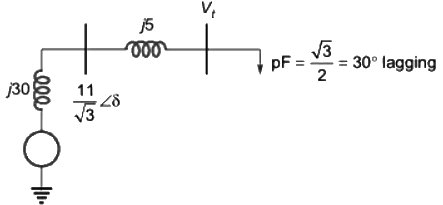

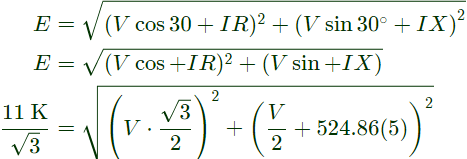
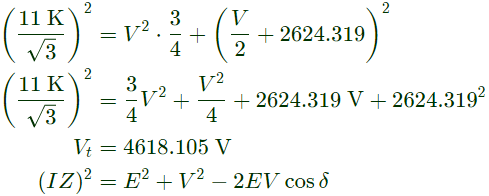
 δ = 20.96
δ = 20.96
pF = cos(20.96 + 30) = 0.629 lagging
Q3: A three-phase synchronous motor with synchronous impedance of 0.1 + j0.3 per unit per phase has a static stability limit of 2.5 per unit. The corresponding excitation voltage in per unit is ____ (Round off to 2 decimal places). (2023)
(a) 0.82
(b) 1.59
(c) 2.25
(d) 3.64
Ans: (b)
Sol: Developed power for motor,
 At max. power developed,
At max. power developed,
δ = θS
and this is decide steady state stability of motor.



Q4: A star-connected 3-phase, 400 V, 50 kVA, 50 Hz synchronous motor has a synchronous reactance of 1 ohm per phase with negligible armature resistance. The shaft load on the motor is 10 kW while the power factor is 0.8 leading. The loss in the motor is 2 kW. The magnitude of the per phase excitation emf of the motor, in volts, is __________. (round off to nearest integer). (2022)
(a) 258
(b) 324
(c) 128
(d) 245
Ans: (d)
Sol: Power input = 10 + 2 = 12kW
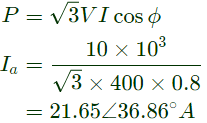 We have, Emf equation for motor
We have, Emf equation for motor
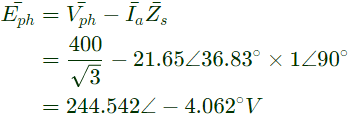
Q5: An alternator with internal voltage of 1∠δ1p.u and synchronous reactance of 0.4 p.u is connected by a transmission line of reactance 0.1 p.u to a synchronous motor having synchronous reactance 0.35 p.u and internal voltage of 0.85∠δ2p.u.
If the real power supplied by the alternator is 0.866 p.u, then (δ1 − δ2) is _________ degrees. (Round off to 2 decimal places.)
(Machines are of non-salient type. Neglect resistances.) (2021)
(a) 60
(b) 25.35
(c) 68.6
(d) 88
Ans: (a)
Sol:  Given real power in (p.u.), P = 0.866
Given real power in (p.u.), P = 0.866


Q6: Consider the table given:
 The correct combination that relates the constructional feature, machine type and mitigation is (2021)
The correct combination that relates the constructional feature, machine type and mitigation is (2021)
(a) P-V-X, Q-U-Z, R-T-Y
(b) P-U-X, Q-S-Y, R-V-Z
(c) P-T-Y, Q-V-Z, R-S-X
(d) P-U-X, Q-V-Y, R-T-Z
Ans: (b)
Sol: P: Damper bars used in synchronous machine (U) to prevent hunting (X)
Q: Skewed rotor slots used in induction motor (S) t avoid magnetic locking (Y)
R: Compensating winding used in DC machine (V) to neutralize cross magnetizing effects of armature reaction (Z) under main poles (polar zone).
Q7: A cylindrical rotor synchronous generator has steady state synchronous reactance of 0.7 pu and subtransient reactance of 0.2 pu. It is operating at (1 + j0) pu terminal voltage with an internal emf of (1 + j0.7) pu. Following a three-phase solid short circuit fault at the terminal of the generator, the magnitude of the subtransient internal emf (rounded off to 2 decimal places) is ________ pu. (2020)
(a) 0.42
(b) 0.82
(c) 1.02
(d) 1.26
Ans: (c)
Sol: Prefault current,
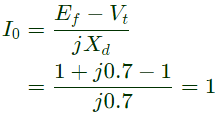
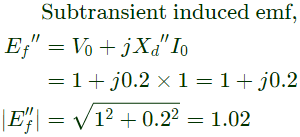
Q8: A cylindrical rotor synchronous generator with constant real power output and constant terminal voltage is supplying 100 A current to a 0.9 lagging power factor load. An ideal reactor is now connected in parallel with the load, as a result of which the total lagging reactive power requirement of the load is twice the previous value while the real power remains unchanged. The armature current is now _______ A (rounded off to 2 decimal places). (2020)
(a) 125.29
(b) 35.45
(c) 85.12
(d) 158.36
Ans: (a)
Sol: 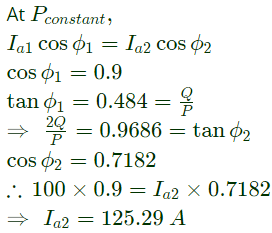
Q9: A single 50 Hz synchronous generator on droop control was delivering 100 MW power to a system. Due to increase in load, generator power had to be increased by 10 MW. as a result of which, system frequency dropped to 49.75 Hz. Further increase in load in the system resulted in a frequency of 49.25 Hz. At this condition, the power in MW supplied by the generator is ________ (rounded off to 2 decimal places) (2020)
(a) 110
(b) 150
(c) 130
(d) 90
Ans: (c)
Sol: Assumed full load frequency is 50 Hz
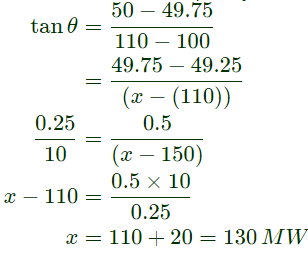
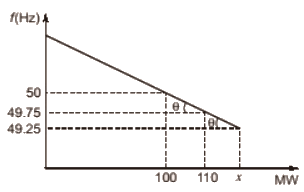
Q10: A three-phase cylindrical rotor synchronous generator has a synchronous reactance Xs and a negligible armature resistance. The magnitude of per phase terminal voltage is VA and the magnitude of per phase induced emf is EA. Considering the following two statements, P and Q.
P : For any three-phase balanced leading load connected across the terminals of this synchronous generator, VA is always more than EA.
Q : For any three-phase balanced lagging load connected across the terminals of this synchronous generator, VA is always less than EA.
Which of the following options is correct? (2020)
(a) P is false and Q is true.
(b) P is true and Q is false.
(c) P is false and Q is false.
(d) P is true and Q is true.
Ans: (a)
Sol: 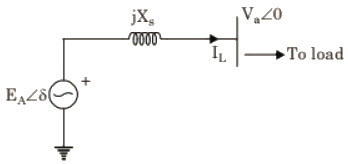 For lagging p.f. load :
For lagging p.f. load :
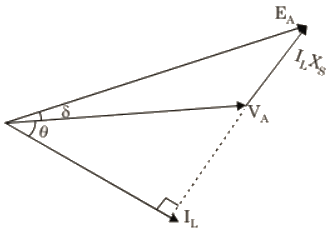 For all lagging power factor loads: EA > VA
For all lagging power factor loads: EA > VA
For unity p.f. load:
 Still we can see : EA > VA
Still we can see : EA > VA
For 'slighlty' load, phasor diagram will be quite similar to that of unity p.f. load, thus EA will be greater than VA. Thus P is false.

Q11: A 220 V (line), three-phase, Y-connected, synchronous motor has a synchronous impedance of (0.25 + j2.5)Ω/phase. The motor draws the rated current of 10 A at 0.8 pf leading. The rms value of line-to-line internal voltage in volts (round off to two decimal places) is __________. (2019)
(a) 456.92
(b) 145.80
(c) 365.24
(d) 245.36
Ans: (d)
Sol: For synchronous motor,
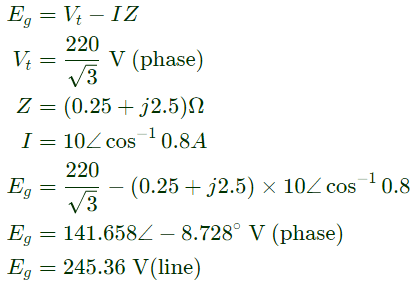
Q12: A three-phase synchronous motor draws 200 A from the line at unity power factor at rated load. Considering the same line voltage and load, the line current at a power factor of 0.5 leading is (2019)
(a) 100 A
(b) 200 A
(c) 300 A
(d) 400 A
Ans: (d)
Sol: P = V I cosϕ
For the same voltage and load,
 at unity power factor,
at unity power factor,

Q13: In a salient pole synchronous motor, the developed reluctance torque attains the maximum value when the load angle in electrical degrees is (2018)
(a) 0
(b) 45
(c) 60
(d) 90
Ans: (b)
Sol: Salient pole synchronous motor power and torque relations per phase:
 The second term is reluctance power or reluctance torque, which is directly proportional to sin 2δ.
The second term is reluctance power or reluctance torque, which is directly proportional to sin 2δ.
Therefore, reluctance torque will be maximum.
When, δ = 45°
∵ sin2(45°) ⇒ sin90° = 1 (Maximum)
Q14: A 3-phase 50 Hz generator supplies power of 3MW at 17.32 kV to a balanced 3-phase inductive load through an overhead line. The per phase line resistance and reactance are 0.25 Ω and 3.925 Ω respectively. If the voltage at the generator terminal is 17.87 kV, the power factor of the load is ________ (SET-2 (2017))
(a) 0.25
(b) 0.50
(c) 0.80
(d) 0.95
Ans: (c)
Sol:
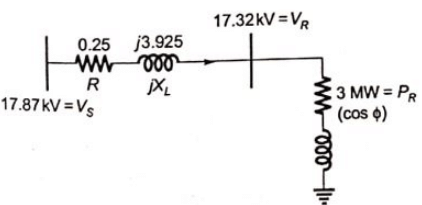
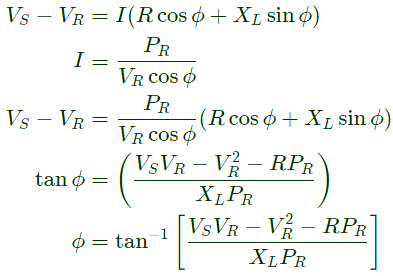 ⇒ substitute all values
⇒ substitute all values
power factor = cos∅ = 0.8 lag
Q15: A 25 kVA, 400 V, Δ-connected, 3-phase, cylindrical rotor synchronous generator requires a field current of 5A to maintain the rated armature current under short-circuit condition. For the same field current, the open-circuit voltage is 360 V. Neglecting the armature resistance and magnetic saturation, its voltage regulation (in % with respect to terminal voltage), when the generator delivers the rated load at 0.8 pf leading, at rated terminal voltage is _________. (SET-2 (2017))
(a) -20
(b) -25
(c) -15
(d) -10
Ans: (c)
Sol: 25 kVA, 400 V, Δ−synchronous generator
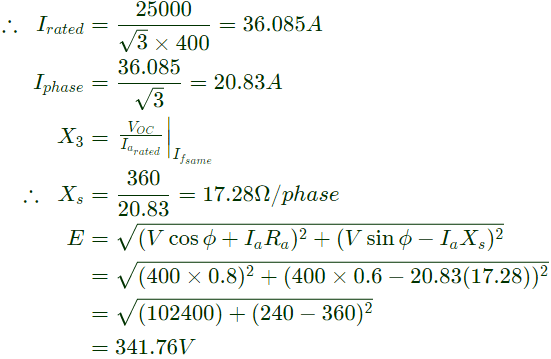


Q16: If a synchronous motor is running at a leading power factor, its excitation induced voltage (Ef) is (SET-2 (2017))
(a) equal to terminal voltage Vt
(b) higher than the terminal voltage Vt
(c) less than terminal voltage Vt
(d) dependent upon supply voltage Vt
Ans: (b)
Sol: Synchonnous motor-leading p.f. over excited.
∴ Ef > Vt
Q17: Two parallel connected, three-phase, 50Hz, 11kV, star-connected synchronous machines A and B, are operating as synchronous condensers. They together supply 50 MVAR to a 11 kV grid. Current supplied by both the machines are equal. Synchronous reactances of machine A and machine B are 1Ω and 3Ω respectively. Assuming the magnetic circuit to be linear, the ratio of excitation current of machine A to that of machine B is ________. (SET-1 (2017))
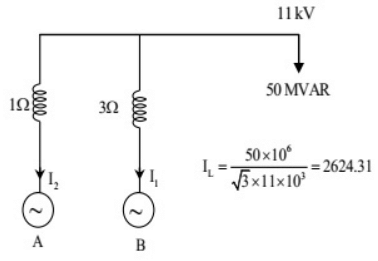 (a) 0.74
(a) 0.74
(b) 1.02
(c) 0.06
(d) 4.09
Ans: (a)
Sol: Synchronous machine A:
11 kV, 50 Hz, Y connected, Xs = 1Ω
Synchronous machine B:
11 kV, 50 Hz, Y connected, Xs = 3Ω
Given both supplying only reactive power 50MVAR tp 11 kV grid equally
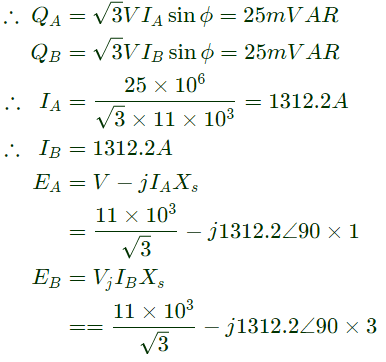 Given magnetic circuit to be linear,
Given magnetic circuit to be linear,
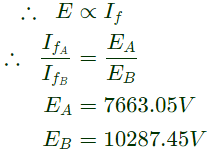 Therefore, ratio of excitation current of machine A to machine B
Therefore, ratio of excitation current of machine A to machine B 
Q18: A three-phase, 50Hz, star-connected cylindrical-rotor synchronous machine is running as a motor. The machine is operated from a 6.6 kV grid and draws current at unity power factor (UPF). The synchronous reactance of the motor is 30 Ω per phase. The load angle is 30°. The power delivered to the motor in kW is _______. (SET-1 (2017))
(a) 2520.5
(b) 1640.8
(c) 838.3
(d) 400.8
Ans: (c)
Sol: For synchronous motor,
 As currrent is drawn at unity power factors.
As currrent is drawn at unity power factors.
Therefore,

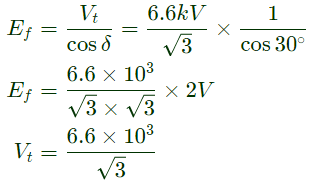


Q19: The power consumption of an industry is 500 kVA, at 0.8 p.f. lagging. A synchronous motor is added to raise the power factor of the industry to unity. If the power intake of the motor is 100 kW, the p.f. of the motor is _____________ (SET-2 (2016))
(a) 0.11
(b) 0.31
(c) 0.66
(d) 0.92
Ans: (b)
Sol: P1 = 500 × 0.8 = 400kW
Q1 = 500 × 0.6 = 300kVAR
The power factor is to be raised to unity
The motor has to supply 300kVAR
The motor rating is 100 kW, 300kVAR
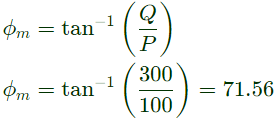 Power factor of motor
Power factor of motor
Q20: A three-phase, 50 Hz salient-pole synchronous motor has a per-phase direct-axis reactance (Xd) of 0.8 pu and a per-phase quadrature-axis reactance (Xq) of 0.6 pu. Resistance of the machine is negligible. It is drawing full-load current at 0.8 pf (leading). When the terminal voltage is 1 pu, per-phase induced voltage, in pu, is _________. (SET-1 (2016))
(a) 0.812
(b) 1.606
(c) 2.425
(d) 3.625
Ans: (b)
Sol: Synchronous motor at leading p.f.
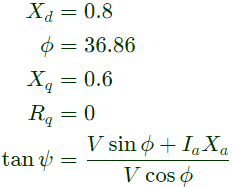
 For synchronous motor at leading p.f.
For synchronous motor at leading p.f.
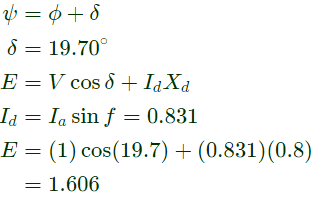




 δ = 20.96
δ = 20.96 At max. power developed,
At max. power developed,


 We have, Emf equation for motor
We have, Emf equation for motor
 Given real power in (p.u.), P = 0.866
Given real power in (p.u.), P = 0.866

 The correct combination that relates the constructional feature, machine type and mitigation is (2021)
The correct combination that relates the constructional feature, machine type and mitigation is (2021)




 For lagging p.f. load :
For lagging p.f. load : For all lagging power factor loads: EA > VA
For all lagging power factor loads: EA > VA Still we can see : EA > VA
Still we can see : EA > VA

 at unity power factor,
at unity power factor,
 The second term is reluctance power or reluctance torque, which is directly proportional to sin 2δ.
The second term is reluctance power or reluctance torque, which is directly proportional to sin 2δ.
 ⇒ substitute all values
⇒ substitute all values


 (a) 0.74
(a) 0.74 Given magnetic circuit to be linear,
Given magnetic circuit to be linear, Therefore, ratio of excitation current of machine A to machine B
Therefore, ratio of excitation current of machine A to machine B 
 As currrent is drawn at unity power factors.
As currrent is drawn at unity power factors.



 Power factor of motor
Power factor of motor

 For synchronous motor at leading p.f.
For synchronous motor at leading p.f.


























